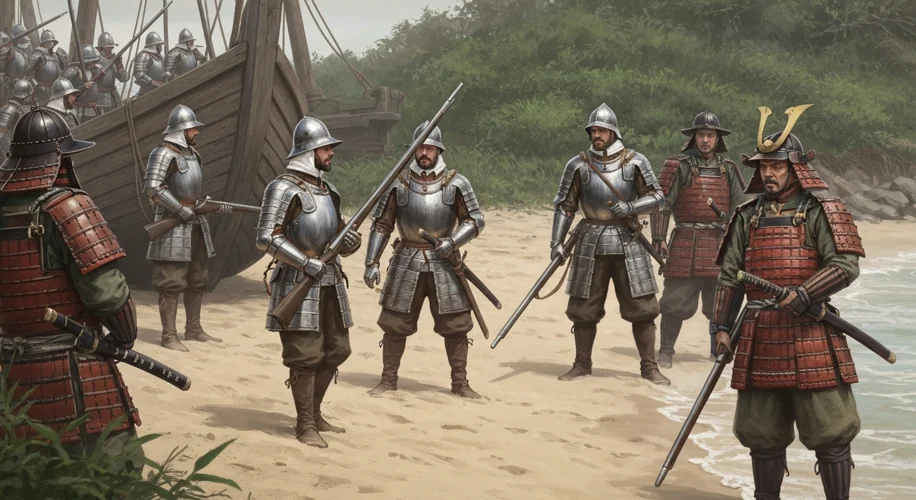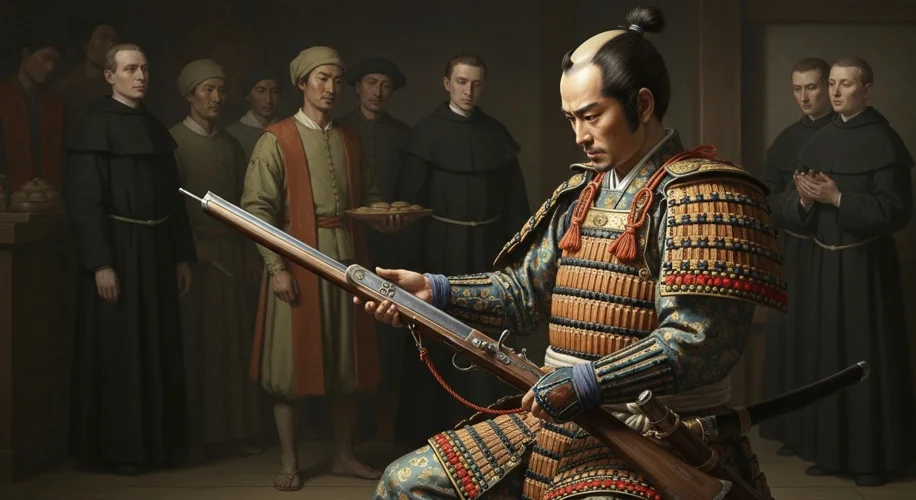The year is 1543. The East Asian seas, usually navigated by junks and dragon-headed ships, were about to witness a new, audacious arrival. A storm-tossed Chinese junk, battered by tempestuous winds, was flung off course and found itself limping towards the shores of Tanegashima, a small island off the coast of Kyushu, Japan. Aboard this vessel were not only Chinese merchants but also a handful of Portuguese adventurers, men whose very presence would irrevocably alter the course of Japanese history.
For centuries, Japan had existed in a state of relative isolation, its culture and society developing along distinct lines. The Sengoku period, or the “Warring States” period, was in full swing. Daimyo, powerful feudal lords, vied for control, their samurai warriors locked in a constant dance of siege and skirmish. Amidst this internal strife, the arrival of these “Nanban,” or Southern Barbarians as they came to be known, was an event of profound, almost alien, significance.
Led by Fernão Mendes Pinto, a man whose colorful and often exaggerated tales would later be recorded in his posthumously published memoir “Peregrinação,” the Portuguese were not merely shipwrecked sailors. They were traders, driven by the allure of exotic goods and the insatiable hunger of European markets for Japanese silver, porcelain, and, perhaps most famously, the exquisite lacquerware and intricately crafted swords that Japan was beginning to produce.
But the Portuguese brought more than just trade goods. They brought a technological marvel that would dramatically shift the battlefield: the arquebus, a primitive but devastatingly effective firearm. The Japanese, accustomed to the clang of steel and the whir of arrows, were captivated by these thunderous sticks that spat fire and death. A local blacksmith, perhaps named Kinpō, is famously credited with reverse-engineering the arquebus, a testament to Japanese ingenuity. Within a decade, Japanese craftsmen had not only mastered the construction of these firearms but had begun mass-producing them, transforming Japanese warfare and giving rise to a new era of battlefield tactics.

The Portuguese, however, were not solely interested in commerce. With them came Jesuit missionaries, most notably Francis Xavier, who arrived in 1549. Xavier, a charismatic and devout figure, saw in Japan a fertile ground for the seeds of Christianity. He learned the language, adapted his teachings, and managed to gain the respect of some local lords. His initial success was remarkable; he baptized thousands, and for a time, Christianity seemed poised to take root in Japanese soil.
These early encounters were a complex tapestry of fascination and apprehension. The Japanese were intrigued by the foreigners’ strange attire, their exotic goods, and their advanced weaponry. They were also wary of their intentions and their seemingly radical religious beliefs. The daimyo, ever the pragmatists, were often willing to engage with the Portuguese, seeing the potential for trade and military advantage. Some even converted to Christianity, not out of deep theological conviction, but for strategic reasons – to secure trade routes and access to firearms.
The initial period of contact, roughly from 1543 to the early 17th century, was a whirlwind of cultural exchange, technological transfer, and religious fervor. Portuguese traders established a presence in Nagasaki, a port city that would become synonymous with both trade and tragedy. Missionaries spread throughout the country, establishing churches and schools. The introduction of firearms led to a brutal arms race among the warring daimyo, inadvertently contributing to the eventual unification of Japan under the Tokugawa shogunate.
However, this era of openness was not destined to last. As the Tokugawa shogunate consolidated power, the foreign influence became viewed as a threat to national stability. The success of Christianity, coupled with fears of European colonial ambitions, led to increasing persecution of Japanese Christians and a gradual sealing off of the country. The Portuguese, and other Europeans, were eventually expelled, and Japan entered its long period of self-imposed isolation, the Sakoku policy. The seeds sown by those first Portuguese arrivals, however, had already begun to sprout, fundamentally changing the military, social, and religious landscape of the island nation forever.
The legacy of this initial encounter is profound. It marked Japan’s dramatic entry onto the global stage, however brief that initial engagement may have been. It introduced technologies that reshaped warfare, religions that challenged existing beliefs, and a glimpse into a world far beyond Japan’s shores. The echoes of these Nanban traders and their faith continue to resonate, a crucial chapter in the complex and captivating story of Japan.

